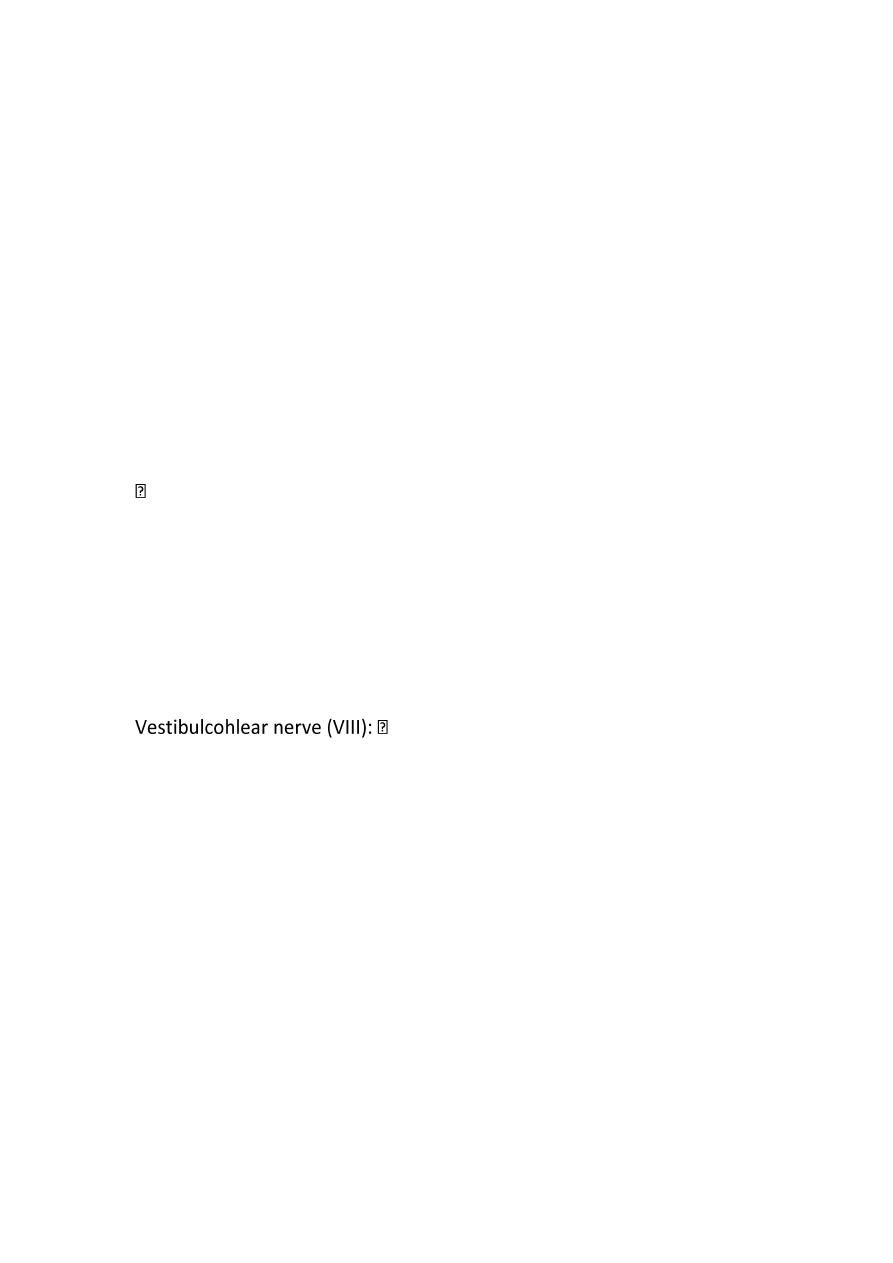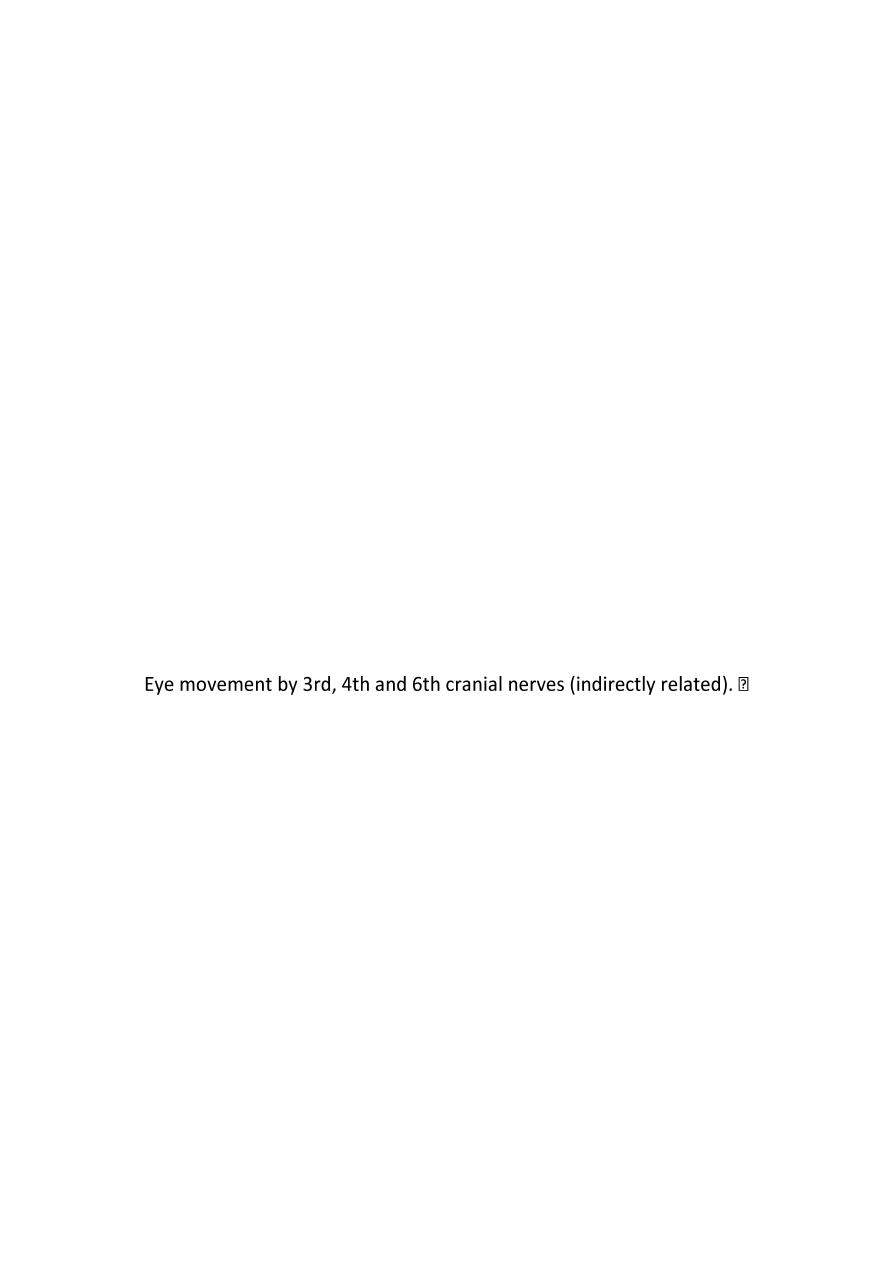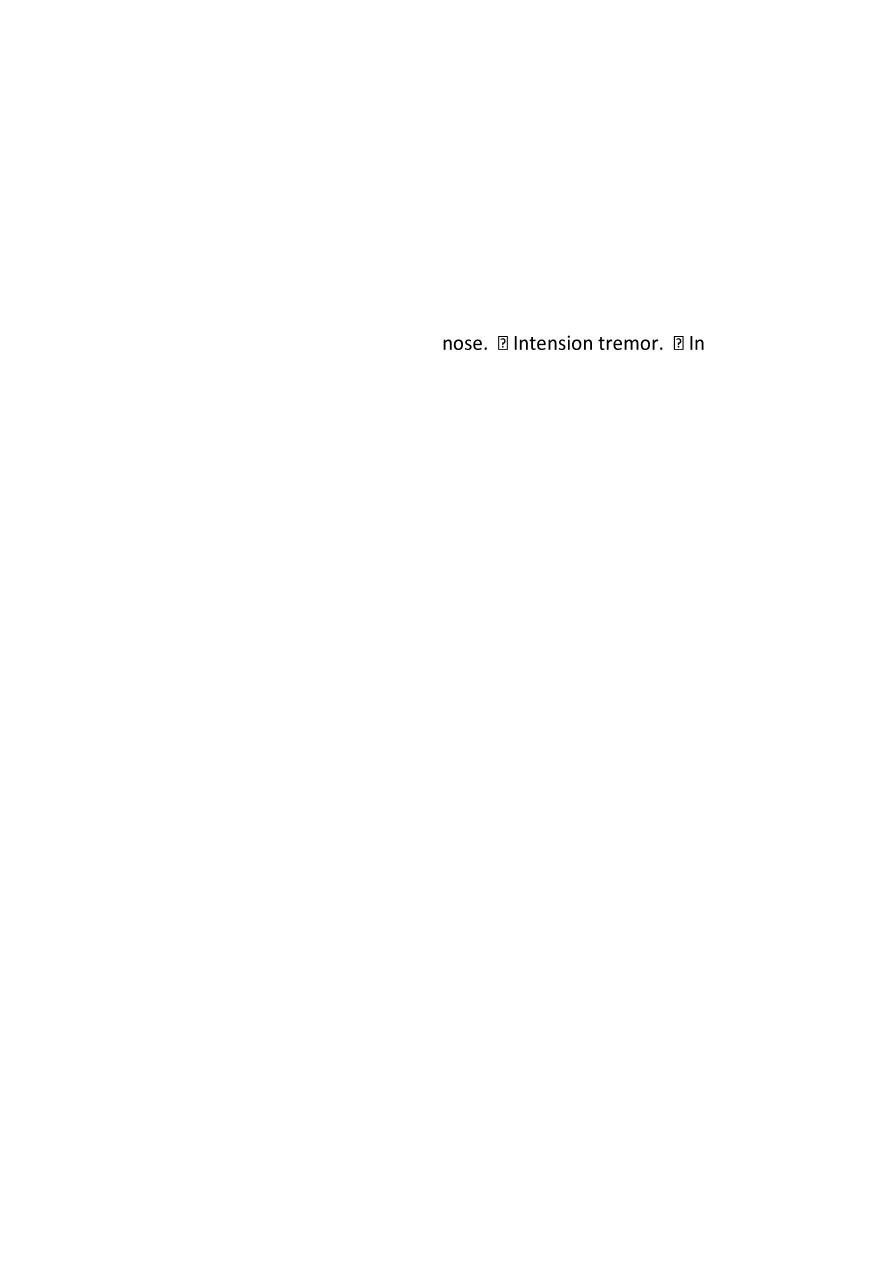
1
Lec.2
Pediatrics
6
th
stage
Session notes
د.اوس حازم
Meningeal signs:
• Causes of meningism:
o Infection meningitis.
o Blood within the subarachnoid space subarachnoid hemorrhage.
o Non-neurological infections urinary tract infection.
• Examination steps:
o Position the patient supine with no pillow
. o Expose and fully extend both the patient's legs.
Neck stiffness:
o Support the patient's head with the fingers of your hands at the
occiput and the ulnar border of your hands against the paraspinal
muscles of the patient's neck.
o Flex the patient's head gently until his chin touches his chest. o Ask the
patient to hold that position for 10 seconds. If neck stiffness is present,
the neck cannot be passively flexed and you may feel spasm in the neck
muscles.
o Flexion of the knees in response to neck flexion is Brudzinski's sign.
Kernig’s sign:
o Flex one of the patient's legs at the hip and knee, with your left hand
placed over the medial hamstrings.
o Use your right hand to extend the knee while the hip is maintained in
flexion. Look at the other leg for any reflex flexion. Kernig's sign is
positive when extension is resisted by spasm in the hamstrings. The
other limb may flex at the hip and knee. Kernig's sign is absent in local

2
causes of neck stiffness, e.g. cervical spine disease or raised intracranial
pressure.
Brudzinski's sign:
o One of the physically demonstrable symptoms of meningitis is
Brudzinski's sign. Severe neck stiffness causes a patient's hips and knees
to flex when the neck is flexed.gns of meningeal irritations :
causes of +ve kernig sign :
1.meningitis
2.increase ICP
Signs and symptoms of increased ICP :
1.Vomiting
2.headache
3.diplopia
4.papilloedema
5.bulging fontanelle
6.ataxia
7.disturbed level of consiousness
8.bradycardia
9.hypertension
10.breathing problem
. abducent nerve palsy
There is convergent squint ( cant abduct ) – paralytic squint

3
. oculomotor palsy :
Divergent squint with ptosis and diltation of pupils ( parasympathatic )
How to differentiate between paralytic and non-paralytic squint ?
By cover test
.facial palsy :
Eye deviation to one side , deviation toward normal , flatrening of
nasolabial fold , disability to close the eye ( UMNL) – Bell's palsy
Check for whistiling , wrinckling of forehead
If all face involved this lower motor neuron lesion
If not all muscle this upper motor neuron lesion
Next exam the ear for Ramsay – Hunt syndrome ( vesicle in the tympanic
membrane )
Exam Blood pressure in Hypertension
Check for Gulliain Barre Paralysis by examination of the lower limb and
ascending upward ,
Cranial nerve exam :
#Examination of the cranial nerves
Start by general exam for example: the baby is conscious alert (small
child) or oriented (older child), normal posture or lying supine or in the
lab of his/her mother, no sequent, no nystagmus, no fascial asymmetry,
no deformity .
Olfactory nerve (I):

4
1-Exam each nostril separately
2-You should confirm that the nostril is patent (Rhinitis (increased
secretion), foreign body obstructing the nostril interfere with smell)
3-Bring familial odors as apple or tea or others in tubes specific for smell
examination
4-Never use irritant smell because its sensed by the ophthalmic division
of the V cranial nerve not olfactory nerve.
Optic nerve (II):
Examination: It has five components to be examined:
1-Visual acuity: Above 4 months you can use Fixation and follow test,
this done by holding an interesting toy about one meter in front of the
baby, once baby fixes his vision to it, you start to move it in an arc, if the
baby follow it, consider that this baby has normal vision.
Below 4 months, the baby can follow faces and light only. Above 7 years
(cooperative child), we can use Snellen chart Sometimes Allen’s chart
(pics of animals with different sizes) can be used below 7 years.
2-Visual field (in cooperative child): One meter distance between doctor
and baby then the doctor closes one eye by his hand and the child asked
to close the eye opposite to the doctor eye, then the doctor start to test
upper, lower and right and left fields of each eye separately by
comparing with his eye considering that the doctor has normal visual
fields.
3-Color vision: (in cooperative and old child): This can be tested by
using Ishihara test, which consist of book containing different figures
with different colors, and the child is asked about these figures
(considering that the child knowing these figures e.g. numbers, pictures
etc.)

5
4-Pupillary reflex: Optic nerve form the sensory (afferent) part of this
reflex, while the motor (efferent) part is oculomotor (will be discussed
next)
Oculomotor, trochlear and abducent (III, IV, and VI):
Examination: These nerves should be examined simultaneously, their
examination consist of three components:
1-Eyeball movement: One meter between the child and examiner:
1-In small child move an interesting toy in H shape pattern and look at
the child if he follow the toy by his eyes, in the same time you should
look for sequent and nystagmus with each movement.
2-In older cooperative child you can move your finger or any object in H
shape pattern and asking him/her to follow, in every movement you
should look for sequent and nystagmus and ask about diplopia.
2-Accommodation:
1-In small child, move an interesting toy toward the nose, normally there
will be ptosis, conversion and meiosis of both eyes. 2-In older child, you
can move your finger or any other object same as above. 3-Pupillary
reflex: Afferent: optic nerve Efferent: Oculomotor nerve This test has
two parts:
1-Direct: By using light torch, come out of the visual field and direct the
light toward the pupil, normally the pupil size will decrease
2-Indirect (consensual): the same maneuver but this time you put a
barrier between the two eyes, then direct the torch toward one eye and
look at the other eye for pupil constriction (normal consensual reflex).
Notes: Types of squint: diversion squint and conversion squint.
Diplopia: as patient looks downward like step down a ladder. Dilated
pupil
3th cranial nerve lesion lead to

6
upward diversion squint + ptosis + lack of accommodation (mydriasis) +
lacrimation also affected .
Trigeminal nerve (V):
Function: motor, sensory, reflexes.
1-Motor: supply the muscles of mastication by the motor fibers of the
mandibular division which includes:
a-Masseter muscle, temporalis muscle: closing the mouth (clenching the
mouth)
b-Lateral ptrygoid muscles: open the mouth and moving the lower jaw
from side to side (lesion in the nerve causes deviation of the jaw toward
it).
2-Sensory: Supply the skin of the face by the three division as follow: a-
Ophthalmic; supply the skin above the imaginary line that runs from the
middle of cranium downward to the lateral angle of the eye. b-Maxillary;
supply the skin below the imaginary line as described above and above
an imaginary line from anterior third of the lateral part of the cranium to
the angle of the mouth. c-Mandibular: supply the skin below the
imaginary line as described in b.
3-Reflexes:
a-Corneal reflex: Afferent: Ophthalmic division of trigeminal. Efferent:
Branch from fascial nerve causes blinking of the eye.
Two ways of examination:
1-Blowing on the child eye (usually not done due to risk of transmit
infection to child as respiratory infection) its positive when the child
blink his eyes.
2-By using cotton, bring it out of the field of the child and touch rapidly
the corneoscleral junction, positive when the child blink his eye(also not
done due to risk of corneal ulceration)

7
b-Jaw jerk:
Afferent: 5th CN mandibular division.
Efferent; 5th CN mandibular division. Ask the child to slightly open his
mouth, put your index finger on the the chin and by taping it by the
hummer, you will notice slight or no upward movement of the jaw
normally, while brisk upward movement seen in upper motor neuron
lesion. .
Facial nerve (VII):
Function: motor supply for fascial muscles and sensation of taste of the
anterior two thirds of the tongue.
Anatomy: nucleus in the pons.
Examination: In fascial nerve you should examine 3 components: 1-
Motor: fascial muscles (4 muscles which are; frontalis, orbicularis oculi,
cheek muscles and orbicularis oris) and this done as follow: a-Ask the
child to look upward while fixing his neck in normal anatomical position,
check for forehead wrinkles bilaterally b-Ask the child to close his eyes
as much as he can till the eyebrow is buried, then try to open his eyes by
your hands to check for resistance .
c-Ask the child to blow against closed mouth, also check the resistance
by pushing his cheeks with your fingers
d-Ask the child to smile, look for the angle of the mouth if they are
normal or there is mouth deviation. If there is a lesion in the right fascial
nerve, the mouth will be deviated toward the normal side. All muscles
affected in upper motor neuron lesion, while only cheek muscles and
orbicularis oris muscles are affected in lower motor neuron lesion,
because the upper two muscles supplied by nerve fibers that come from
the upper half of fascial nucleus, and the lower two muscles supplied by
nerve fibers that originate from the lower half of fascial nucleus, the
upper half has innervation from both cerebral hemispheres therefore
when the fibers come from one hemisphere affected, the branched from

8
the other side will take its place, while lower half of the nucleus take
innervation only from the ipsilateral hemisphere, therefore when its
fibers damaged nothing take its place!
2-Sensory: it takes taste sensation of the anterior two thirds of the
tongue by its sensory branch, chorda tympani. To examine this typically
the tongue should be pulled by forceps out of the mouth, and then put
drops of specific taste on its specific are of sensation (sweet on the
anterior part of the tongue, salty and sour on the lateral side and biter
on the posterior part of the tongue)
#Note: Ramzi Hunt syndrome, its herpes zoster of the sensory part of
the fascial nerve of part of the external auditory canal.
Note: o Glabellar reflex: elicited by repetitive tapping on the glabella
(area on the forehead between the eyes) normally person blinks in
response to several tapes then no response, if persistent cerebral palsy
(abnormal) Myerson's sign.
o Facial nerve palsy: Upper motor neuron lesion: only lower part
affected (toward lesion). Lower motor neuron lesion: Bell's palsy, all
sites of face, no wrinkling, deviation of mouth toward same side .
1-Hearing:
a-Audiometery; it’s a device that needs cooperative child > 5 years
b-Tunic fork; used in children > 5 years, also needs cooperative child.
c-Distraction test; could be used in babies > 4 months, this can be done
by two examiners one stand infront of the child having an interesting toy
in his hand and the other examiner stand behind the baby, when the
child fixes his vision to the toy in
front of him/her, the examiners behind will produce a sound, if the child
turn his head toward him, means his hearing is ok.

9
2-Balance:
a-Nystagmus: there are 3 types, transverse, vertical and arc movement.
You can examine for it by two methods:
1-Water caloric test: a-warm water (44C and above) introduced in the
external auditory canal, head will turn to the ipsilateral side, both eyes
will turn toward contralateral side with horizontal nystagmus toward the
ipsilateral ear. b-Cold water (30 C or below) introduced in the external
auditory canal, head will turn to the contralateral side, both eyes will
turn toward the ipsilateral side with horizontal nystagmus toward the
contralateral ear.
2-Hallpike test; Check Macleods for further information b-Ataxia:
Incoordination of body movement .
Glossopharyngeal and vagus nerves (IX and X):
Examination: You should examine these nerves together and start as
follow:
1-The Uvula, should be central, if there is lesion in one side the uvula
should deviated to the normal side. Ask the baby to say Ahh to
demonstrate the uvula clearly.
2-Gag reflex; by touching the posterior wall of the pharynx by tongue
depressor (afferent by glossopharyngeal), this will cause contration of
the pharyngeal muscles (efferent by vagus nerve), this reflex induces
sense of vomiting .
Accessory nerve (IX):
1-Ask the baby to elevate or shrug his shoulder, and push against his
shoulders by your hands.
2-If the child is small, move an interesting toy in front of him from side
to side to check for sternocleidomastoid muscles 3-If the child is old and
cooperative ask him to look to the side, the push his jaw by your hand
and ask him to push against your hand .

11
Hypoglossal nerve (XII):
Examination: (you need cooperative child):
1-Examine the tongue in resting and look for:
a-Wasting
b-Fasciculation (fibrillation when seen on EMG, but in tongue
examination we can use both words)
2-Exmine the tongue after asking the baby to protrude his tongue out of
the mouth and look for a-Weakness b-Deviation (deviation is toward the
abnormal side)
3-Then ask the baby to close his mouth and push his cheeks by his
tongue .
#Baby during feeding uses 9 cranial nerves:
Eye to eye contact with mother by optic nerve (indirectly related).
Muscles of mastication by V CN (directly related).
Facial muscles (sucking muscles) by VII CN (directly related).
Muscles of deglutition by IX and X CNs (directly related).
Swallowing (tongue) by XII CN (directly related.)
If more than 7 years :
1.olfactory
2.optic
Visual acuity : snellen chart
Visual field : con frontation test or perimetry
Papillary reflex

11
3 , 4 , 6 ( H-shape )
5 cranial nerve ( trigeminal )
Sensory
Motor ---> mastication
Jaw jerk reflex ( +ve UMNL )
Corneal reflex
Facial deviation to normal side , flattening of nasolabial fold to the
affected
8 cranial ( vetibulocochlear ) :
Whisper in child ear
9 , 10 cranial nerve : swallowing , say ahh there is uveal move
Bulbar palsy ( UMNL ) , psedoubulbar ( LMNL )
Pseudobulbar ( supra-nuclear ) , bulbar ( infra – nuclear )
NG tube or gasrostomy
Post 1/3 of 9 GN taste
Acessory n.
12 cranial nerve : tongue affected deviation , fasiculation , wasting
-vagus : uveal pulled to normal side
1 min. Is enough for test
In infant :
Sucking 9 , 10 ( swallowing ) look to his mother
Toy for 3 , 4 , 6
Crying for facial palsy deviation

12
Jaw jerk
Orientation : time , palce , consiousness , languge
Exam limbs :
Appeareance
Seizuring of leg : CP , wasting of muscle
Feel
Tone ( ankle , knee , hip )
power
reflex
how to do propioception
explain for patient
upward and downward move of toe
-plantar reflex
Romberg sign +ve ( close eye , and deviated or fall if –ve cerebellar
Speech ( dysarthyia )
Dysmetria
Nystagmus ( rapid " jerk " - cerebellar )
To the affected side
Reflex can by finger in finger
Cerebellum signs:
Ataxia = drunken gait.
Hypotonia.

13
Nystagmus: vertical, horizontal, rotary // abnormal rhythmical
oscillatory movement of the eye.
Dysdidokinesia: inability of the cooperative child to perform rapid
alternating movement (pronation and supination) of the one hand over
the fixed and extended other hand.
Dysartheria (slurred speech).
Dysmetria: over shooting of finger-
-
coordination .
Cerebellum examination:
Assessment of slurred speech and dysartheria.
Dysdidokinesia
: impament of ability to make movements exhibiting a
rapid change of motion that is caused by cerebellar dysfunction.
Overshooting (dysmetria): ask child to catch something you hold (toy).
Intention tremor: detected during hand shaking.
Dysmetria: finger-nose test.
Gait: ataxia.
Co-ordination: heel-shin test (abnormal when they are unable to keep
foot on shin .)
Reflexes examination:
Knee reflex
appropriate exposure, tap the tendon, see the contraction of
quadriceps.
Ankle reflex
appropriate exposure, tap the tendon, see the contraction of calf
muscles.
Babinski reflex

14
one of the reflexes occur in infants, responses when body receives
certain stimulus, after sole of foot firmly stroked
big toe upward and others fan out
normal in children up to 2 years and disappear as child gets older, may
disappear as early as 12 months.
